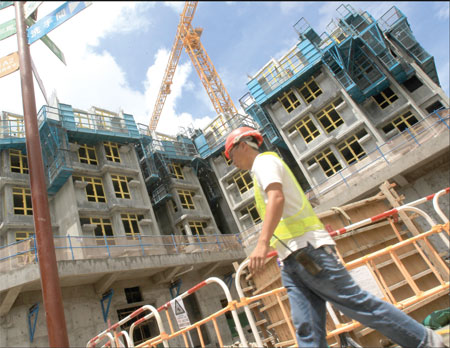CE revives HOS, adds land supply
Updated: 2011-10-13 09:56
By George Ng(HK Edition)
|
|||||||||
|
A construction worker walks past a building site in eastern Kowloon. Chief Executive Donald Tsang, in his last policy address on Wednesday, announced the resumption of the long-awaited Home Ownership Scheme, along with measures to augment land supply, to cope with housing woes being felt across the city. Edmond Tang / China Daily |
Donald Tsang pledges to meet target of 40,000 residential units every year
Chief Executive Donald Tsang, responding to widespread pressure that had extended for more than a year, announced, in Wednesday's policy address, that the Home Ownership Scheme (HOS) is coming back.
In its latest bid to cool the overheating property market and maintain healthy development in the long-term, the government pledged the revival of the HOS, to offer subsidized flats, as well as additional measures in order to boost the land supply.
"Our aim is to ensure an annual supply of land for an average of about 40,000 residential units of various types," Tsang said in his final policy address.
The figure includes 15,000 public rental flats, 20,000 private homes and around 5,000 subsidized flats, he revealed.
As widely expected, the government decided to revive the defunct scheme to build and offer an average of 5,000 small and medium-sized subsidized homes annually, or more than 17,000 flats in total over four years commencing in 2016.
Families whose monthly income is less than HK$30,000 will be eligible.
The pledges came after home prices in the city surged more than 70 percent since the beginning of 2009, with the market driven by short supply, abundant liquidity, ultra-low interest rates and strong demand from mainland buyers, depriving many low-to-middle-income families of the chance to own a home.
"When private housing is in short supply and property prices rise to a level beyond people's purchasing power, the government has to intervene," the Chief Executive asserted.
"Basically, I favor the measures, although the government is a bit late in resuming the subsidized housing scheme," said Raymond Wong, a 39-year-old office clerk, who hopes to buy his first home this year.
"It won't help those who need to buy a flat now, as the first batch of HOS flats will not be available until 2016," said Wong Leung-sing, research head at Centaline Property Agency Ltd.
Instead, he suggests the government revitalize the HOS secondary market by allowing so-called sandwich-class families to buy existing HOS flats without repaying subsidies the government gave to the original buyers.
The analyst believes the revival of the HOS will have little influence on private home prices.
Meanwhile, he reckoned that the planned private flat supply of 20,000 units annually is an "appropriate" figure.
"Twenty-thousand units will barely meet market demand for private homes," he said, predicting stable home prices unless there is a contraction in the economy.
Apart from resuming the HOS, the government also revised the previously announced "My Home Purchase Plan" (MHPP), a scheme to provide a total of 5,000 "no frills" small and medium-sized rental flats to middle-income families whose monthly household income is less than HK$39,000.
Qualified applicants for the modified "rent to own scheme" will be allowed to buy an MHPP flat direct at market price without going through a rental period, Tsang said on Wednesday.
He noted that the first batch of MHPP flats will be available by 2014.
Originally, the scheme allowed eligible applicants to rent a MHPP flat for a maximum period of five years.
After two years' rental, a tenant would be offered alternatives to purchase a flat with a government subsidy - he could buy the flat he rented, or another flat under the MHPP scheme, or a private home, at prevailing market prices.
The subsidy would be a rebate equivalent of half the net rental the tenant had paid during the tenancy period, as a partial down payment to buy the home.
The revival of the HOS and the implementation of the MHPP won't have a significant impact on the private home market as the new flats - mostly small and medium-sized - will be made available in batches.
That will allow private developers time to adjust their project development strategy, said Justin Chiu, executive director of Cheung Kong (Holdings) Ltd.
Private developers nowadays are inclined to build big apartments, which are more profitable.
Chiu also believes that the government is moving in the right direction with its newly announced housing policies.
He said the policies should contribute to a more stable society.
To meet its target of providing 40,000 flats annually, the government will strive to build up its land reserve, the Chief Executive said.
The government will release 60 hectares of industrial land for non-industrial uses, half of which will be made available for housing, he said.
It will also study the feasibility of reclamation outside Victoria Harbour and the use of rock caverns to reposition existing public facilities and release currently occupied sites for housing and other uses.
Meanwhile, it will consider converting deserted green belt areas in the New Territories into housing sites, with the first phase covering an area of 50 hectares, mainly government land, Tsang said.
The government will also consider converting into housing land some 150 hectares of agricultural land in North District and Yuen Long.
The lands are now being used mainly for industrial purposes or for temporary storage. Some of the lands are vacant.
The housing policies will help the government put the land resources into more efficient use and will help maintain stable land supply, said Sun Hung Kai Properties Ltd in a statement.
george@chinadailyhk.com
China Daily
(HK Edition 10/13/2011 page1)
